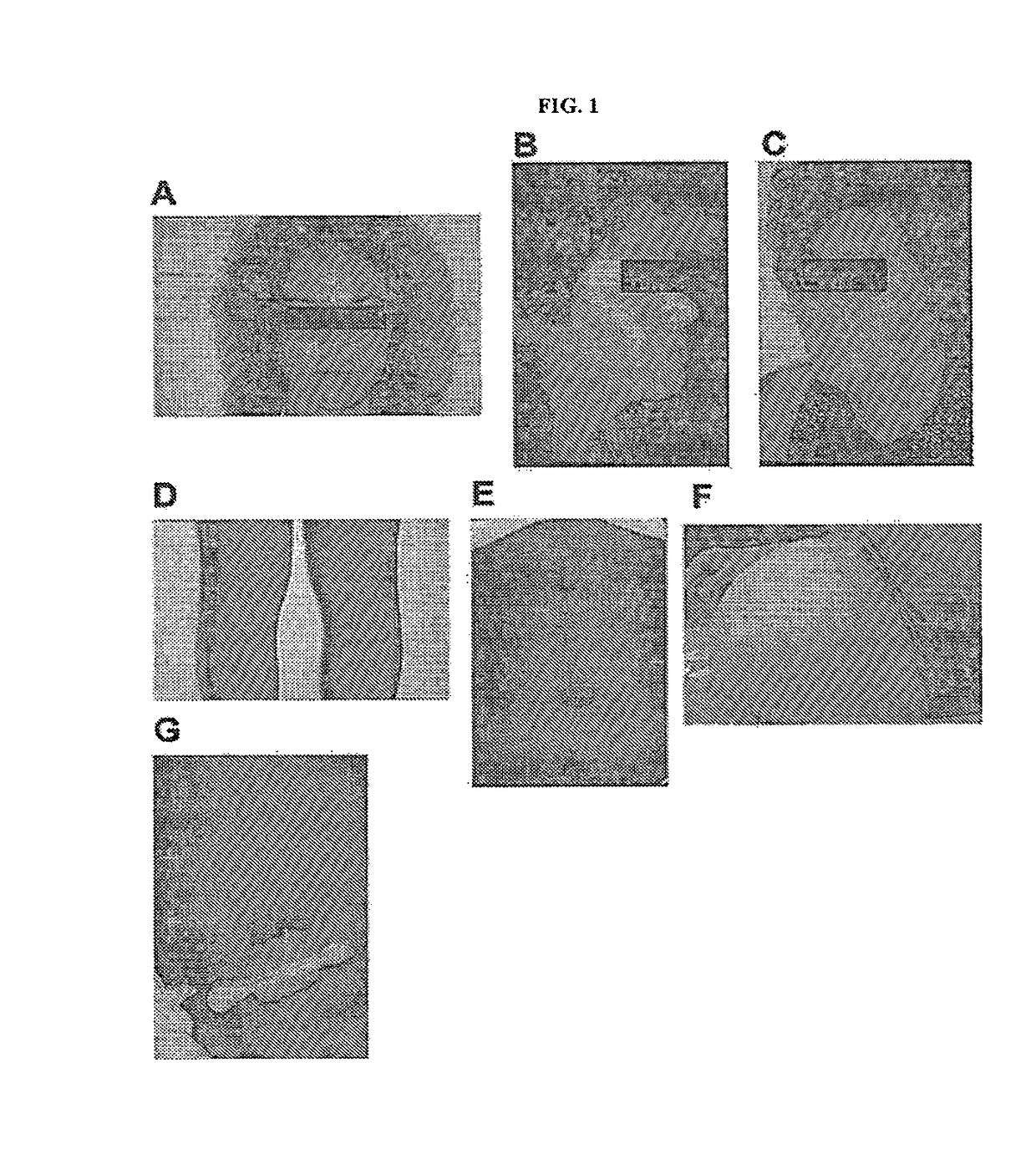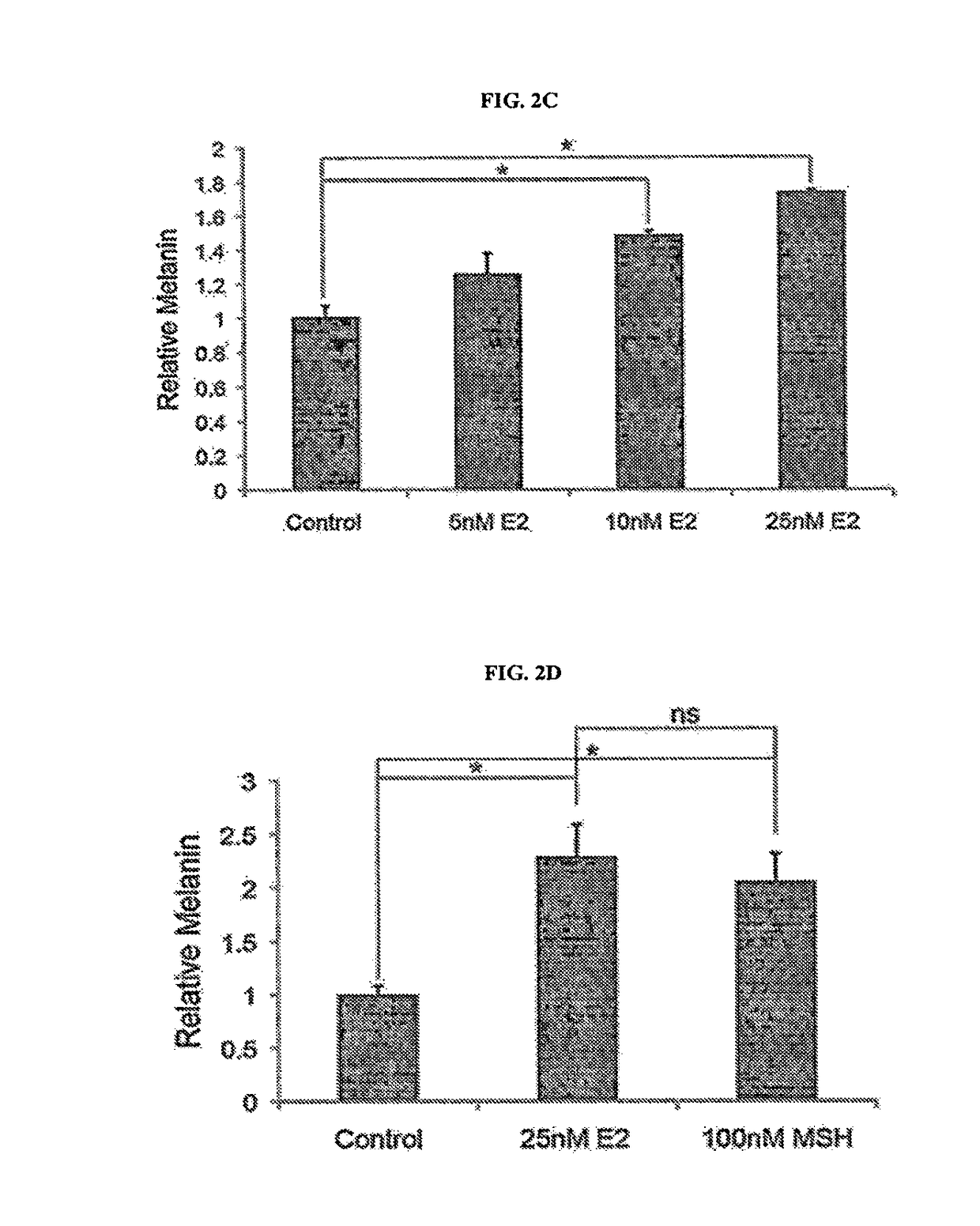Compositions and methods for decreasing, or preventing or reversing gain of, skin pigmentation in a mammalian subject
a technology of skin pigmentation and composition, applied in the field of compositions and methods for reducing, preventing or reversing the gain of, skin pigmentation in a mammalian subject, can solve the problems of excessive exposure to ultraviolet light damage to health, discoloration or freckling, discoloration, etc., and achieve the effect of decreasing, skin pigmentation, and preventing or reversing the gain of skin pigmentation
- Summary
- Abstract
- Description
- Claims
- Application Information
AI Technical Summary
Benefits of technology
Problems solved by technology
Method used
Image
Examples
example 1
Preparation of 3-D Organotypic Skin Cultures
[0183]Organotypic skin grafts containing MCs were established using modifications to previously detailed methods (Ridky, et al., Nature Med. 2010, 16, 1450-1455; Chudnovsky, et al., Nature Gen. 2005, 37, 745-749). The Keratinocyte Growth Media (KGM) used for keratinocyte-only skin grafts was replaced with modified Melanocyte Xenograft Seeding Media (MXSM). MXSM is a 1:1 mixture of KGM, lacking cholera toxin, and Keratinocyte Media 50 / 50 (Gibco) containing 2% FBS, 1.2 mM calcium chloride, 100 nM Et-3 (endothelin 3), 10 ng / mL rhSCF (recombinant human stem cell factor), and 4.5 ng / mL r-basic FGF (recombinant basic fibroblast growth factor). 1.5×105 melanocytes and 5.0×105 keratinocytes were suspended in 80 μL MXSM, seeded onto the dermis, and incubated at 37° C. for 8 days at the air-liquid interface.
example 2
Estrogen and Progesterone Reciprocally Regulate Melanin Synthesis
[0184]To examine whether sex steroids directly influence melanin synthesis, normal primary human melanocytes was treated with estrogen (17β-estradiol), which resulted in a dose dependent increase in melanin production (FIG. 2C). 25 nM estrogen were used for subsequent experiments, a medically-relevant concentration observed during second and third trimester pregnancy. After 4 days, melanin production was markedly increased (208±27%) (FIG. 3A). The change in melanin production was similar in magnitude to changes observed with αMSH (FIGS. 2B & 2D). This melanin-promoting estrogen effect was consistent with involvement of estrogen in melanin synthesis. To examine the effects of estrogen on melanocyte homeostasis in the context of intact human epidermis, architecturally-faithful 3-D organotypic skin was established utilizing normal primary epidermal keratinocytes and melanocytes within the framework of native stroma and in...
example 3
Primary Human Melanocytes do not Express Nuclear Estrogen or Progesterone Receptors (ER / PR), and Respond to Sex Steroids Via Altered cAMP Signaling
[0188]To determine the mechanisms through which estrogen and progesterone mediate their pigment effects, components of the canonical pigment production pathway were examined. An increase in cAMP upon estrogen treatment (FIG. 4A) was observed. This suggests that estrogen accesses the canonical pigment production pathway downstream of MC1R. Consistent with this, pCREB and MITF proteins were similarly induced (FIG. 4B). In contrast, progesterone treatment resulted in diminished pigment production, with corresponding decreases in cAMP, pCREB and MITF (FIGS. 4C-4D).
[0189]Without wishing to be limited by any theory, these data suggest that estrogen, progesterone, and α-MSH converge on the canonical melanin production pathway at the level of adenylate cyclase to reciprocally modulate melanin synthesis. Consistently, the estrogen pigment effects ...
PUM
| Property | Measurement | Unit |
|---|---|---|
| w/w | aaaaa | aaaaa |
| time | aaaaa | aaaaa |
| time | aaaaa | aaaaa |
Abstract
Description
Claims
Application Information
 Login to View More
Login to View More - R&D
- Intellectual Property
- Life Sciences
- Materials
- Tech Scout
- Unparalleled Data Quality
- Higher Quality Content
- 60% Fewer Hallucinations
Browse by: Latest US Patents, China's latest patents, Technical Efficacy Thesaurus, Application Domain, Technology Topic, Popular Technical Reports.
© 2025 PatSnap. All rights reserved.Legal|Privacy policy|Modern Slavery Act Transparency Statement|Sitemap|About US| Contact US: help@patsnap.com



